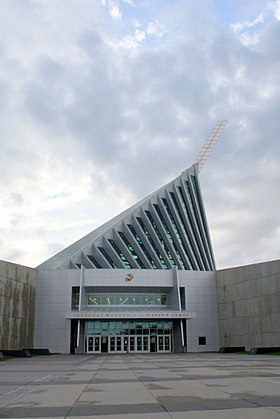Marine Corps Heritage Foundation
 |
|
| Established | 2006 |
|---|---|
| Location | 18900 Jefferson Davis Highway (see US Route 1 in Virginia) Triangle, Virginia |
| Coordinates | 38°32′39″N 77°20′36″W / 38.544139°N 77.343361°WCoordinates: 38°32′39″N 77°20′36″W / 38.544139°N 77.343361°W |
| Type | Military History |
| Public transit access | none |
| Website | www |
The National Museum of the Marine Corps is the historical museum of the United States Marine Corps. Located in Triangle, Virginia near MCB Quantico, the museum opened on November 10, 2006, and is now one of the top tourist attractions in the state, drawing over 500,000 people annually.
In July 2013, the museum announced plans for a major expansion, to include sections on more modern Marine Corps history, such as the 1983 Beirut barracks bombing, a combat art gallery, and a war on terror gallery.
The museum replaces both the Marine Corps Historical Center in the Washington Navy Yard, which closed on July 1, 2005, and the Marine Corps Air-Ground Museum in Quantico, Virginia, which closed on November 15, 2002.
A public-private venture, the museum is a cooperative effort between the United States Marine Corps and the Marine Corps Heritage Foundation. The Foundation manages the museum operation, while the museum building will be donated to the Marine Corps.
Designed by Curtis W. Fentress of Fentress Architects, the museum's exterior is meant to "evoke the image of the flag raisers of Iwo Jima," an image that is also preserved by the Marine Corps War Memorial. A replica of the "Iron Mike" statue at Marine Corps Base Quantico stands to one side of the main entrance.
The museum is 100,000-square-foot (9,300 m2), and is open to the public with free admission.
Established in 1979, the Marine Corps Heritage Foundation is a private, non-profit organization that supports the historical programs of the Marine Corps. In 1999, the Foundation expanded its mission to include the creation of the National Museum of the Marine Corps.
...
Wikipedia
